|
|
Welcome to my travel log! You will find here a lot more than in the travel reports, stripped from political correctness. Enjoy! 
Dec 20, 2004 07:00 PM West Africa - Dakar (SN) to Banjul (GM)
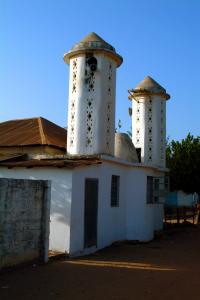 When I returned to my hotel, I realised that I made terrible mistake in calculating at what time I would need to get up to travel all the way to Dakar, pick up my passport with (hopefully) stamped visa from the Malian Embassy, and catch my flight to Banjul in the Gambia.
When I returned to my hotel, I realised that I made terrible mistake in calculating at what time I would need to get up to travel all the way to Dakar, pick up my passport with (hopefully) stamped visa from the Malian Embassy, and catch my flight to Banjul in the Gambia.
My flight was at 10:30 am, and there were four hours to drive from Saint-Louis to Dakar. The embassy was opening at 9 am and I had to be at the airport no later than 10 am. It was only possible if I could get up at 4:15 am and get on the road at 4:45 am.
Two days earlier, I made an arrangement with a taxi driver (the same who took me to the Birds’ Sanctuary of Djoudj), to pick me up at the hotel at 7 am. I was so lucky that I checked my flight ticket that evening and that I got a mobile phone number for this guy. That was about 10:30 pm and I managed to convince the receptionist of the hotel to phone the taxi driver and push forward the departure. That was not a problem for anyone, whatsoever.
I was happy, when I saw the man and his taxi waiting for me by the hotel entrance at 4:45 am as agreed, as I knew I should be able to get to the airport on time with the passport stamped with the Malian visa. If all goes well, I might add.
He must have been very happy to see me, too. I paid him CFA 40,000 for the ride (although he demanded only CFA 35,000).
The driver suddenly stopped for prayer in the bush – literally in the middle of nowhere and it was still dark. Although I was in a rush I did not mind since he was driving very well... over the speed limit - some 170 kilometres per hour (106 mph).
I noticed that a lot of people in Senegal were travelling simply by waving their hands at any passing vehicle hoping to be taken on board.
By the way, about the speed again. As I mentioned, I was travelling at 170 km per hour in Africa, during the hours of darkness. That is not advisable and I definitely do not recommend that. On my speedy way to Dakar, I had a near miss with donkeys crossing the road. My taxi driver avoided them in a very last second, raising all hair on my back. It was an interesting feeling full of adrenaline absolutely everywhere. Well, as it turned out, I was lucky again.
Many people however, did not have my luck and neither did goats, lambs, calves, dogs, donkeys and other creatures lying lifeless on the road immediately turning into fodder for vultures and hyenas.
|
Dec 19, 2004 07:00 PM Senegal - Saint-Louis; day two
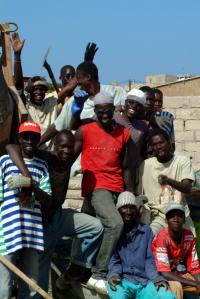 The historic town of Saint-Louis, a former capital of West Africa, exhibits an important exchange of values and influences on the development of education and culture, architecture, craftsmanship, and services in a large part of West Africa.
The historic town of Saint-Louis, a former capital of West Africa, exhibits an important exchange of values and influences on the development of education and culture, architecture, craftsmanship, and services in a large part of West Africa.
It is an outstanding example of a colonial city, characterized by its particularly natural setting, and it illustrates the development of colonial government in this region.
Nevertheless, I think that I misjudged the length of time I would need in Saint-Louis and the surroundings to see everything or appreciate it. I guess overstayed. The town is quite small and there is not an awful lot to do there. I wandered along and across the town several times and I was bored at the end of the day. Weather was good, but the beaches in the town were filthy and the good ones were kilometres away. Apart from the one at the end of the country, were I did not feel comfortable staying as I could not see the border and I did not have a visa to Mauritania.
I probably should have gone to Touba for a day and admire what the Muslims of Senegal admire – a great mosque and a sanctuary. Instead, I ended up sleeping in and going over and over to the same places on the island of St-Louis and the odoriferous and extremely dirty ocean front parts of it – Guet Ndar and Ndar Tout.
When I was walking along the waterfront, the range of odours and stench overshot all possible levels of my tolerance for bad smell and I was nearly sick. Someone was painting a boat there and I was ever so happy to be able to recognise for the first time one of the scents – the fresh paint.
But, I do not regret anything, since the slow pace for this very beginning of my holiday was enjoyable and the colonial feel at the more restored parts of the town was a great component of the atmosphere.
The restaurants in the town were also very good. The Casino Restaurant, for example, offers slow service in the first place and then a choice of seafood, of course, and a small range of pizzas. Their delicate red house wine is rather watery but I guess it goes down well with their slightly salty pizzas. Downstairs, they also have a discotheque, which does not get full until we hours in the morning. The disco’s theme changes every night, revolving from the obvious Senegalese night to generally African to European, Jamaican, etc.
Before the Casino, I tried the Flamingo Restaurant right on the Senegal River. They serve excellent seafood soup with croutons and cheese and fantastic a fish fillet. I was in heaven! At least this is what my taste buds and my stomach thought anyway.
Also, right at the front of the Flamingo Restaurant, there was a great Jazz café called Marco Jazz with interior covered by silver graffiti and furnished with hyper comfortable sofas. I will not even begin to try describing Marco’s choice of repertoire. Let’s just say that I simply loved this place.
On day, I decided to go far, away from the tourist centre of the town, and explore more original or traditional town. I wanted to have a look at the households of the people living simultaneously by the Senegal River and the Atlantic Ocean. The walk involved marching by the terribly smelly riverbanks or petty fish and meat markets for about twenty minutes. I could quite imagine that my clothes absorbed all that smell and I just could get that thought out of my head. Brrr!
The only positive thing over there was that people in the northern part of the city were so much nicer than in the central island of Saint-Louis. They did not jump on you trying to sell you something. The kids did not make sad faces asking for CFA 100, pen or a gift. It was different – more pleasant and chilled. I could even play a little with them on the beach.
After spending maybe half an hour with them, I took them to a little kiosk and told them that they could pick any type of sweet or biscuit and I would get it for them. This made them even happier and the owner of the shop was in the seventh heaven as well. So much business in one go!
I was later passing by, and actually also interrupting, the construction of a new road all the way to the border with Mauritania. It was being built in a conventional way, completely manually and of concrete.
The guys building the road were very funny and they looked like they enjoyed their work. It was hard and I knew they were working long hours, but they all smiled and wanted me to take a picture of them very much!
I must have taken twenty pictures of them actually. One of the guys gave me his address and asked if I could send the copy to them. I took the address and I promised that I would send them the photographs. Then, back in the town I discovered a photo lab, which could print pictures from digital memory cards. I had an idea that I could print some of the pictures and walk all the way back and hand them to the lads.
The printer was of a very good quality but it was painfully slow. I printed ten copies of one photograph and I took it to the guys. They could not actually believe they could see the results so quickly and I could see this must have made them very happy!
They wanted even more pictures to be taken, so I took another dozen, but those, I said, would have to be sent to them after my holiday, because the printer in the lab would have taken a week to print them all. That was not their concern.
|
Dec 19, 2004 07:00 PM Mauritania - just across an undemarkated border
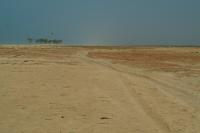 Beyond the road works, the town suddenly ended with derelict structure of some sort, military radar and a magnificent and surprisingly clean beach.
Beyond the road works, the town suddenly ended with derelict structure of some sort, military radar and a magnificent and surprisingly clean beach.
Mauritania border is vaguely marked and people enjoy the passage with no control. I was cautious about all this, because I was not sure how far I could go before being caught of crossing the border illegally. I could see people disappearing behind dunes far on the horizon. I knew there were many Moors living in Senegal, and could see many of them dressed in deep blue robes in the area heading north. I suspected then, the either I already crossed the border or would have done should I proceed with a few more steps north.
The place was completely dry. I could imagine dunes building up larger and larger and the desert appearing right after the horizon line. I thought I could see a sand storm on the horizon as well. However, the place where I was standing was peaceful. It was actually incredibly calm and only the ocean with its oversized waves was breaking up the silence every now and again.
|
Dec 18, 2004 07:00 PM Senegal - Djoudj
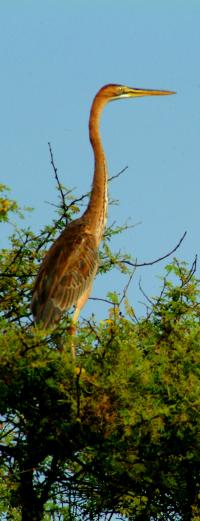 Situated in the Senegal River delta, the Djoudj Sanctuary is a wetland of sixteen thousand hectares, comprising a large lake surrounded by streams, ponds and backwaters. It forms a living but fragile sanctuary for some one-and-a-half million birds, such as the white pelican (on the photograph above), the purple heron, the African spoonbill, the great egret and the cormorant (also on the photograph above). It is officially called Parc National des Oiseaux du Djoudj.
Situated in the Senegal River delta, the Djoudj Sanctuary is a wetland of sixteen thousand hectares, comprising a large lake surrounded by streams, ponds and backwaters. It forms a living but fragile sanctuary for some one-and-a-half million birds, such as the white pelican (on the photograph above), the purple heron, the African spoonbill, the great egret and the cormorant (also on the photograph above). It is officially called Parc National des Oiseaux du Djoudj.
It is said to be the world’s third most important birds’ sanctuary. The majority of the birds are migratory and they arrive to Senegal from Europe just before the wintertime. It has been proven that the pink flamingo, for example, comes to Djoudj from Camargue near Montpellier in southern France.
The National Park of Djoudj is very near Saint-Louis, some 60 kilometres (37 miles) and the road is quite good. The ride takes bout 45 minutes and it is one of the key escapades organised by all the travel agencies in the town, and quite possibly in the whole Senegal. It is a UNESCO inscribed site. Even though, I did not spot many tourists there.
I was so excited to go to the park and see the fowl but I was already stricken by the beauty of the area. As soon as the road turned from asphalt to a dirt track, the scenery changed dramatically to a red soiled semi-desert. Termites’ towers popped up every few hundred meters, and I could even see several large nests of the local eagle. I just could not see the eagle from close, as it was hiding there protecting its babies, apparently. I could see it from the distance, sticking its head out off the nest lurking for something or maybe checking for eventual danger.
Right on the way to the boat landing, I could see entire families of warthogs grazing on the weak grass, and even a jackal cunningly avoiding my camera.
There were two or three small villages as well, with their small round houses. I could not spot many people, though, and I am not sure what they could be possibly doing, living in a national park.
It is crucial to go on the boat in the park if one would like to see birds in their large numbers. It is possible to see a few pelicans, cormorants, ducks and possible white egrets on the lakes by the track, but the serious volumes are deep in the wetland, away from the road.
I went on a long wooden motorboat with few other tourists, who were in the area. The boat could probably accommodate twenty people, but there was only six of us, including three French, who refused to allow me to join them in the car. How rude is that?!
Since the trip to the park is so popular, I could not get a trip over there from any of the hotels in the town. I was directed to go to the tourist office, which should provide me with more information. When I got to the office, they told me that they can organise for me and asked me if I wanted to join either the three French tourists or one Japanese. Joining the French would make the trip of four people, and would reduce the price from CFA 20,000 to CFA 16,000. I said that it would be better to do that. However, I had to agree that the guide would speak French only. That was absolutely fine for me, since I was not going to the park to have deep conversations but to watch the birds.
When I turned up in the morning at the indicated location, not only was the car late but also I found myself with the company of the single Japanese tourist, rather than those three French. The guy immediately told me that the French did not want my company. That was very interesting to hear, since the Frogs have never met me, however they decided that I could not possibly be a good person or travel companion for that matter, so they told the agency that they do not want me to join them on this short trip. I cannot over emphasise how unimpressed I was of the fact.
Unfortunately, the French did manage to earn a reputation for themselves of being rude, offensive, condescending, arrogant and disrespectful. This reputation is known in the entire world, and I say it is unfortunate, because I have very good French friends. But what do I say to this incident in Senegal’s Saint-Louis?
Well, let’s come back to the story. The boat ride was supposed to take two hours, but it lasted merely an hour, which was a bit too short to admire the herds. I am not sure what was the reason for this discrepancy, but I did feel that the boat was travelling too fast and the escapade was being rushed. A lot of the birds flew away as the boat with us was approaching them so fast. I could not even hold my camera steady, without mentioning that the birds were too far away, escaping any potential encounter with the fast moving and noisy motorboat in which I was stuck.
That was so unfair, because there were some interesting species of birds that I could recognise from Europe. Many of them can be spotted in the vast Mazuria’s lake district in North-East Poland. Had we travelled slower and quieter we would have been able to enjoy more of them from very close. It would have been more enjoyable and relaxing giving a great chance for unforgettable morning.
What I particularly wanted to see on this ride were pink flamingos. I have been chasing them in Cuba and in southern France. Never did I have a chance to come close or to see them in very large numbers.
What I actually saw in the Djoudj Sanctuary, was an uncountable number of pelicans, cormorants, snake birds, and great egrets.
There were a few other, less significant species of herons and ibises (far away from me and I could not see them properly). However, not a single flamingo! I was so disappointed. I met a few of them in Camargue earlier that year and I wanted to say hi. And congratulate them on their successful trip from France. Tough!
On the way back to Saint-Louis, I saw many more warthogs and village people. The Japanese guy stopped to take a picture of rather smallish termite tower.
In the hotel, or I think it was actually on the rooftop terrace, I reviewed the pictures I so spontaneously took in the Sanctuary and deleted more than sixty percent of them. They were all pelicans. And almost all of them were showing a pelican in the same position on the water.
In the hotel, I was staying there were several posters advertising Senegal to tourists and most of those posters were showing the Parc National des Oiseaux du Djoudj with many different shots of birds. I did not notice anything dramatically better than my photographs, so I decided it was a good enough morning.
|
Dec 17, 2004 07:00 PM Senegal - Saint-Louis; day one
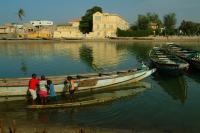 I could not make my mind on the way to travel from Dakar to St-Louis. The options included a taxi-brousse or a regular taxi. The first one is a Peugeot 505 altered to transport seven people inside and twice its weight of luggage on its roof. The latter is the simply a taxi – a regular passenger car, usually Mercedes, Toyota or Nissan. The former costs about 5-10 percent of the price for the latter, depending on one’ negotiation skills with the regular taxi driver.
I could not make my mind on the way to travel from Dakar to St-Louis. The options included a taxi-brousse or a regular taxi. The first one is a Peugeot 505 altered to transport seven people inside and twice its weight of luggage on its roof. The latter is the simply a taxi – a regular passenger car, usually Mercedes, Toyota or Nissan. The former costs about 5-10 percent of the price for the latter, depending on one’ negotiation skills with the regular taxi driver.
I was seriously struggling to make the decision. Travelling cheaply had its advantage of having spent little on this holiday, but the comfort of the ride was seriously questionable. The private taxi was expensive, but it offered comfort and incomparable flexibility. With those only two variables, decision could never be easy.
Well, yes, it depends on priorities and principles as well, but hey, that was just the beginning of my holiday… and I just spent two nights in a very comfortable hotel full with all amenities of an international top end hotel. You can guess I eventually opted for the private taxi, with the damage of CFA 50,000. It was not too bad, considering the trip takes four hours. Still, I would like to consider this quite extravagant and almost unacceptable to be doing on your own.
Right after Rufisque, on the way to Thiès, Senegal’s second city, great clusters of massive baobabs grow right by the road. Sometimes entire forests cover the distance between your car and the horizon. They make a great picture of the landscape’s slides passing by your window. It finally makes it feel African after leaving the busy, smelly, overcrowded, uninspiring and cosmopolitan Dakar.
Farther on, in Lam-Lam, after Thiès, even more of those pop up by the road. I could not resist and stopped the car to take a few pictures.
Then, something really strange happened. The static landscape, as compared with that passing by your car’s window, did not look so imposing. I thought I stopped in a wrong spot, at the wrong angle, but I made a few hikes to ensure I am capturing the scene correctly. In vain! I cannot explain this completely, but I was not very satisfied with my shots, I do not think that appropriately reflect the scenery and the atmosphere there.
I must have spent more than a quarter of an hour trying to position myself on the right spot to take this perfect picture. I was wandering farther and farther from the taxi frantically staring through the lens disbelieving that I simply could not take this shot. It was escaping me completely that the same landscape looked so differently from the moving vehicle that from a given spot on the road or even in the field.
I was so disappointed. I had the picture of the Baobabs Avenue of Morondava (Madagascar) in my head, and I thought I could capture something like that over there as well. The scene had all the potential, because the number of the baobabs there around Thiès was so much greater than that one around Morondava.
I was passing the same scenery on the way back to Dakar three mornings later. The light was on the way back different, because it was earlier in the morning and the longer shadows made the landscape even more attractive… again only from the moving taxi.
When I arrived in Saint-Louis, I thought I was in a wrong place. It looked completely different from what I was imagining it from many descriptions of it in numerous publications. Well, maybe I should have let my imagination loose like that.
The very first disappointment hit me at Hotel du Palais. I made a reservation there by email and still they refused to accept me.
Later, when I logged several days after I left Senegal (It was actually in Mali) I received a confirmation of my booking by email from the hotel’s manager. Why therefore did they tell me there was no room when I turned up? I think I duly responded to that email with the adequate level of bitterness and discontent.
After a few unsuccessful attempts to get accommodated, I found a room in rather nice Hotel Residence. It was clean and super-centrally located with a great view from the sun-terrace. I loved that terrace, I could watch the people below stirring, chatting, trading, going about their business, and seat at a table and read my book trying to figure out what I could see next in the area.
It is a UNESCO inscribed site, so no-one should treat the place lightly, carelessly or disrespectfully. The United Nations decided it was a significant site for human kind and the entire planet, and people should value and protect that.
Founded as a French colonial settlement in the 17th century, Saint-Louis was urbanised in the mid-19th century. It was the capital of Senegal from 1872 to 1957 and played an important cultural and economic role in the whole of West Africa. The location of the town on an island at the mouth of the Senegal River, its regular town plan, the system of quays, and the characteristic colonial architecture give Saint-Louis its distinctive appearance and identity.
|
Dec 16, 2004 07:00 PM Senegal - Ile de Goree
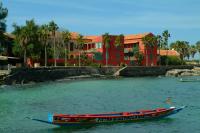 Right on the next day, after I landed in Senegal, I headed to the Island of Gorée. It is a small island, some 2km off the coast of Dakar, maybe a little bit more. It takes twenty minutes by a passenger ferry to get there. It is quite a nice place with pretty colonial architecture and gloomy history of the slave trade. It was in fact one of the key departure points to the Americas, mainly Brazil.
Right on the next day, after I landed in Senegal, I headed to the Island of Gorée. It is a small island, some 2km off the coast of Dakar, maybe a little bit more. It takes twenty minutes by a passenger ferry to get there. It is quite a nice place with pretty colonial architecture and gloomy history of the slave trade. It was in fact one of the key departure points to the Americas, mainly Brazil.
UNESCO inscribed the island in 1978 for the reason of it being a significant site on this planet that played a very important role in the human history.
The island of Gorée lies off the coast of Senegal, opposite Dakar. From the 15th to the 19th century, it was the largest slave-trading centre on the African coast. Ruled in succession by the Portuguese, Dutch, English and French, its architecture is characterized by the contrast between the grim slave-quarters and the elegant houses of the slave traders. Today it continues to serve as a reminder of human exploitation and as a sanctuary for reconciliation.
Although the stories about the numbers of slaves dispatched from the site are vastly exaggerated, the island continues to receive a lot of attention from the entire planet. Many politicians and even heads of states visit the slavery museum, including Nelson Mandela of South Africa and George W. Bush of the United States. The story I heard from a local (and very greedy guide) spoke of over 30 million slaves departed from the site.
He also told me in all honesty that it was the black people who sold their brothers and sisters to the Portuguese, French and the English. Many African-Americans do not want to believe in this, though. However, the slavery was a direct result of tribal wars inside the African continent. Since the tribes wanted the guns and the gun powder so they could fight other tribes, they began to supply the Brazilian sugar cane and coffee plantations with free labour quite happily without any scruples or reservations.
The fact the Portuguese, French, and English exploited the opportunities to a gigantic and indecent scale was simply an aftermath. So, both of them are guilty in equal measures. What surprised me the most was that I heard this from a black person.
The colonial buildings on the island are painted in vivid colours. The island enjoys clusters of trees and very relaxed atmosphere. It is a tourists place, but people are more laid back than on the mainland.
The shop owners smile more often and wider and are less insisting. Some of them have interesting acrylic paintings. Many of the sellers claimed that it was them who made the paintings, but they all looked suspiciously in the same style and quality. I therefore did not believe them 100 percent. I liked them though and I actually bought two – one with red background, the other with blue one. I did spend a lot of time choosing since they all looked alike.
The island is pleasant enough that it could be enjoyed for an entire day on a very easy pace. However, the guide who showed me around insisted on having discussion on making more business with me. I quickly realised that I wanted nothing with him when he threw a price of CFA 600,000 (GBP 640) for an organised trip to one of the nearby sites, Saint-Louis and the National Birds’ Park of Djoudj.
I actually laughed in his face saying that he completely misjudged me. I told him that I was not expecting to spend more than that for my entire trip to West Africa nevermind just three days in Senegal. Although I did not realise then that in fact it was going to be much more, due to the unforeseen circumstances. Interestingly, he was not surprised with my rather spontaneous reaction.
However, I was offended by this price and became very angry although I managed not to show it. I understand there are differences in the European and African cultures, which I should accept rather than judge.
|
Dec 15, 2004 07:00 PM West Africa - Paris to Dakar
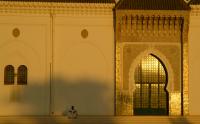 As I was departing, I still did not have my visa to Mali. The plan was to get one in Dakar. The guidebooks stated that it should be fairly easy without any excess hassle.
As I was departing, I still did not have my visa to Mali. The plan was to get one in Dakar. The guidebooks stated that it should be fairly easy without any excess hassle.
That was in fact true, and I got my Mali visa in Dakar in the Embassy of the Republic of Mali. There were no excessive questions asked, just filling the form, two photos and the fee to pay. As I went there on Friday morning, my visa was ready for collection on Monday afternoon. Easy!
I heard about Senegal from travellers when I was in Namibia in 2002. They were telling about the exceptionally beautiful people and great colonial architecture in a few cities around the country, as well as about the country’s passion to football.
I could recognise the passion to football, as I always preferred watching the African football to the over-commercialised European version of it. And I could most definitely feel that the stories about the incredibly stunning people must have been true as I already have seen gorgeous African people in Madagascar, Namibia and even Egypt. So, I was not surprised to hear that someone else was so very much impressed by the beauty of the Africans in Senegal.
That was the very reason I wanted to go to this country. It was not the only one though, as I made investigations before I decided definitely to go to Senegal.
The capital city of Senegal is modern and noisy. It is busy and not too easy to navigate or walk around.
Unfortunately, it has few attractive places or pieces of architecture that could be admired. The more interesting buildings are the train station, the Great Mosque, the presidential palace and maybe the Chamber of Commerce, but that is about it. There are a few colonial buildings around the centre, but the overwhelming rest is rather uninspiring and concrete. It is also under maintained and rather dull.
After a few hours, I was lost looking for something to photograph, and a bit worried that I would have to be back in Dakar twice more while completing my journey in the region. Fortunately, I could adjust my route to avoid coming back to the city. The single item kept me thinking of coming down to the centre was the existence of ATM cash machines.
Even the posh hotel (Sofitel Teranga) right in the heart of the city, in which I was staying for the first two nights, did not help. Furthermore, the taxi drivers at the hotel’s ramp were even greedier trying to rip you off that it actually put me off entirely.
On Friday afternoon, I embarked on visiting the city. At the Presidential Palace a police officer was very impressed with my camera. He could not believe it was a digital camera and that it was so nice and heavy. I was in turn impressed with the palace and the two guards at the gate. I wandered around a little bit more, but I could not find anything photo-inspiring, unfortunately.
Later, two guys began to stick with me. Followed me around making me turn to streets I would have never gone into. I actually liked it. These streets were quite animated with markets and smelly shops, and no tourists. They did not appear to want anything, but practise their English, which was not too bad at all. They showed me around and I felt more comfortable to take my camera out and photograph whatever.
Samba, a boy who when smiling could be an exact double of the actor Djimon Hounsou (Amistad, Gladiator, To America) but slim, showed me town. He mainly took me to markets and trading streets, showed me that colourful train station and the Malian market. He was happily married with two children and a third on its way, but rather poor.
He was in fact a tout for a craft shop, but also an artists playing on drums in the evenings from 11pm. Working long hours does not allow him to enjoy his family life as much as he would like to or anyone would like. I am sure his children miss him very much, but that is the reality in Africa.
Kids grow up there very quickly. Practically, at the age of five they fully apprehend the struggle, working hard in the field, taking care of their younger brothers and sisters, dreaming that when they are fully grow up, they will be able to operate some agro machinery. Their dreams tend not to orbit too close to the reality rather fantasy.
Samba was wearing shattered clothes and flip-flops months past their expiry date. He was in heaven (or its Muslim equivalent) when I offered that I would buy him a pair of new trainers. It was only CFA 15,000 and it made me feel so good to see him so happy. It was a good day. In the night Samba took me to N'Gor a pretty beach rather close to the airport. I liked the place so much that I decided to make a reservation there for my last day in Senegal.
|
Dec 14, 2004 07:00 PM West Africa - The Plan...
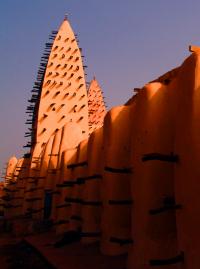 I drafted a plan after spending weeks and weeks on reading vague and ambiguous information in a number of guidebooks. I reserved a ticket to Accra in Ghana, and tried to work out the rest of the logistics. That plan was being born in pain. I simply could not find the necessary information how to move from one place to another. If I had unlimited time to travel there, then it would not bother me. However, my holiday had a specific number of days in it and I had to be back at work on a specific day.
I drafted a plan after spending weeks and weeks on reading vague and ambiguous information in a number of guidebooks. I reserved a ticket to Accra in Ghana, and tried to work out the rest of the logistics. That plan was being born in pain. I simply could not find the necessary information how to move from one place to another. If I had unlimited time to travel there, then it would not bother me. However, my holiday had a specific number of days in it and I had to be back at work on a specific day.
Well, I drafted an itinerary and built a considerable flexibility within it – just in case. It started in Accra, Ghana proceeding to Banjul and the Atlantic coast resorts of the Gambia; Dakar and the UNESCO sites of Senegal; then Mali and finally Burkina Faso – immediately before stepping back to Accra again and fly back to Europe. That route remained at the ‘initial’ or ‘planning’ stage for months.
The idea of the itinerary was there, but the practicalities around the logistics and how to move from one country to another was a challenge. It turned out that to get out of Ghana in any direction towards The Gambia or Senegal was not easy or cheap at all.
Then, a miracle happened. As I embarked on the process to obtain the necessary visas, I stumbled in the Embassy of Senegal. They refused to issue me with a visa unless I could show them a ticket from London to Senegal and a local hotel booking. My ticket to Accra did not suffice, and neither my explaining that I travel independently and decide where exactly I go or sleep whilst I am already there. Although the guy was very friendly, he appeared a bit square to me and I even thought he might have wanted a bribe or something.
Well, I had to book a fresh ticket from Paris to Dakar and book a hotel, otherwise I could forget about getting a visa. By the way, citizens of member states of the European Union do not need a visa, but the new 10 member states were not included in this equation.
Buying a ticket to Dakar meant that I had to change the itinerary. This however, turned out to be a good move since I did not have to worry about finding suitable connections from Accra.
I cancelled my ticket to Ghana and started plotting a route from Dakar as the point of entry and departure. The logistics became a lot easier from Senegal. It was relatively easy to find direct flights between the capital cities of the region – I mean between Dakar, Banjul, Bamako and Ouagadougou. And by the way, that was exactly the sequence I decided to go for.
First, spending a few days in Senegal meeting the people and exploring the UNESCO sites, then fly to Banjul in the Gambia to unwind on the beaches before moving to Mali and trek in the country of the Dogons. Burkina Faso was reserved for a dessert and my birthday.
I had to call Las Palmas on the Canary Islands (Spain) in order to book the flights between Dakar, Banjul and Bamako with Air Senegal International. This is because the Senegalese airline does not provide the service of online booking on their website. Also, the telephone numbers that they quote on their website are incorrect. None of the numbers in France was correct and even the Las Palmas number had changed, but fortunately the Spanish telecom company was kindly informing what the actual number was.
Ordering the tickets in Spanish for an airline of Senegal at the office of Royal Air Maroc based on the Canary Islands was an unexpected experience.
I did not realise that Air Senegal International was part of the Group Royal Air Maroc, who have offices on Regent Street in London. This was exactly, where I had to pay and collect my tickets. This was however easy compared to the other flight that I booked with Opodo.
It was not easy to find out about the connections between Burkina Faso and Senegal, but eventually I managed to get the information from www.amadeus.net, who not only provide timetables but also show availability. That is actually quite coo. What is not cool that it is not possible to book through them. This is why I went to www.opodo.co.uk and booked the flight from Ouagadougou and Dakar.
I was happy it worked. As usual, I received an email confirmation from Opodo with my reservation number and the information that my credit card was successfully charged.
Then, I received a phone call and another email saying that Opodo sold me a ticket on an airline they do not have a ticketing agreement. How can they do that? I guess they should not have sold me the ticket in the first place. The email was asking me to provide them with details of the international carrier so they could issue the ticket otherwise I can forget about travelling!
This is the email they sent me:
“Dear Mr Dudek,
Thank you for choosing to book your forthcoming flights with Opodo.
The flight itinerary that you have selected is with an airline carrier for whom we currently do not hold a ticketing agreement. In order to try and fulfil your reservation, I would be grateful if you could provide the following by 25th of November 2004. Once we have received this information, I can speak to the international airline to see if we are able to use them to issue your tickets.
We need to know which airline is your international carrier. Due to the type of ticket that has been purchased, I will need to release your seats back to the airline after this time if you are unable to provide this. Notification after this time may result in additional monies being required to process your booking.
I look forward to hearing from you within the next 24 hours and our Customer Service Team can be contacted on 0870 241 7051 if you require any further assistance.
Thank you for allowing us to be of service to you.
Yours sincerely,
Jay Patel
Opodo Ticketing Team
www.opodo.co.uk”
I could not be more confused than that. Air Burkina is an international carrier and not only do they have scheduled services between West African countries but also a regular service to Europe (Paris). So, they are most definitely an international carrier. I had no clue what Opodo was asking me for?
Did they expect me to tell them how to do their job and how to identify an airline that may, perhaps, be able to issue the ticket for them? How am I supposed to know with which airlines Opodo have ticketing agreements and with which they have not?
I thought that Opodo was a reliable agent, but I might have been so wrong! I mean – can you believe that email? They sell me a ticket and then say that they cannot issue it. And if I do not identify an airline, which may be able to issue the ticket for them, they will cancel the reservation and even charge me more if they wish!
Eventually, they sent me another email explaining that they needed details of an airline with which I was entering Burkina Faso. They must have been shitting themselves when I replied that I was not travelling to Burkina Faso on air but land. However, I was good enough to tell them also that I was travelling on Air France–KLM from Europe to Dakar and Air Senegal International from Dakar to Bamako.
Finally, Air France-KLM agreed to issue my Air Burkina ticket on their paper, so the unnecessary meshiver was over.
Nevertheless, it was still three weeks before the holiday and levels of adrenaline in my blood were already high. I just wondered what it was going to be actually on the holiday itself.
Obtaining the Burkinabe visa was piece of cake. It was equally easy as the visa to the Gambia. Your passport is stamped as you wait and the entire procedure takes about 10-15 minutes. That is a difference in comparison with the annoying bureaucracy at the Senegalese Embassy.
I think all countries should implement such procedure. This is 21st century and quick checks should be possible anywhere on this planet. Or rather, it should be possible to obtain a visa on entry. This is very convenient, traveller and tourism friendly, which means money for the country’s budgets, does it not?
Originally, I did not know that Burkina Faso had a diplomatic representation in the United Kingdom, but it does. I found out about it from the Burkinabe Embassy in Brussels, who kindly informed me by email. I was ever so happy, because it naturally meant that I already saved myself the worry of getting a visa in Senegal or Mali.
|
Sep 11, 2004 02:00 PM Peru - a few words about the people...
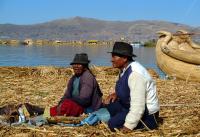 The good, the bad and the ugly...
The good, the bad and the ugly...
The following comments are my personal experiences at the time of my visit, and are not my opinion about Peruvians.
The good
Children, grandmas and shoe cleaners, most of them still children anyway, are all good. The children are quite cute, smile a lot and are very funny. They are the future! I have seen so many kids during this trip, and most of them were hardworking, trying to support themselves and their families. I have been a loser again as I forgot to take an instant photograph camera, like the Polaroid. Again! It is so simple to give such an exciting present to kids in places where photographs are only taken by tourists passing by, and their family’s picture boxes are completely empty. The grandmas are warm-hearted, have sad eyes and wear those traditional clothes and hats. Some of the hats are seriously good quality. They are the wisdom and deserve all the respect we can give them.
The shoe-cleaners are everywhere! They hunt their preys looking first at the potential customer’s footwear. Although not everyone would agree with their sales technique, based on a simple sentence – ‘your shoes are dirty!’, this is their way of earning money. In fact, in almost all cases the shoes in question are actually dirty. It is also a genuine job and the shoe-cleaners’ prey is not limited to foreign blood only. Many Peruvian gentlemen use the street shoe cleaning service.
The bad
Whilst in Peru, one should be careful with the currency exchangers in the streets, or better have no contact with them at all. They are all, with categorically no exception, crooks and their sole objective is to rob you, cheat you, trick you and swindle you. Their approach is also quite aggressive and they would try all sorts of cons to convince you to do business with them one way or another. Actually, there are ‘genuine’ bureaux de change dotted along main streets in every single town in Peru. However, personnel there are bad, too. The rates are disgrace there and the people over the counter would lie to you that the rate recently dropped and that’s why this is what they use. I personally think it is a crime. The only good and safe way to exchange currency in Peru is in a bank.
The taxi drivers have not been my favourite kind of people either. They all think that you are completely stupid and would agree to whatever price they quote. This is actually seriously offending to me, but I guess this could be just me, who has been around and knows how to find out what the taxi fare should be!
And the ugly
Unfortunately, that would be a vast proportion of Peru’s population. Somehow, I struggled to identify pretty faces around the country. There might have been few people who were handsome, but the less attractive rest overwhelms them thoroughly. I know this may be cruel, and not a very nice thing to say (I might have said that before, actually) but this is my true observation.
|
Sep 10, 2004 02:00 PM Peru - Huanchaco, the last day
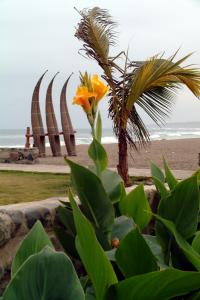 Another plus of visiting Huanchaco is cheap pearls. They come in three different colours: pearl, pink and black. Necklaces, bracelets and earrings are the most popular shapes they are being sold in.
Another plus of visiting Huanchaco is cheap pearls. They come in three different colours: pearl, pink and black. Necklaces, bracelets and earrings are the most popular shapes they are being sold in.
Thick mist like in the one in Schwakopmund in Namibia blocks the sun for the entire morning and sometimes also for the entire day, which is disappointing when you just arrived at the seaside to conclude your holiday! Tough, and fortunately, the Chimu ruins are close.
There it is – 9 am; I am standing in the street on Saturday morning trying to get a taxi to take to Trujillo airport so I can catch my plane to Lima and then London. I did not book a taxi, because there were always a large number of them everywhere.
However, as there are thousands of taxis going in every possible direction at any given point, you might be actually standing at one point in time, when there is not a single one. This is the point in time when you actually need one. That is a Murphy’s Law, and it works even in Peru.
Planes in Peru are never full but one could be told otherwise. There were a few occasions when I was told that the plane was full, but when you actually get on it, there are still a large number of seats available.
|
Page:
 91 92 93 94 95 96 97 98 99 100 101
91 92 93 94 95 96 97 98 99 100 101

|
|
|
